The ski season is under way and the roads north are busy with mountain travellers, often with a roof box on their car. But in a crash, the box and its contents could be a real danger to other road users.  Testfakta asked SP Technical Research Institute of Sweden to crash test seven different plastic roof boxes at a speed of 40 kilometres per hour. Several of the boxes did very poorly – either they flew of the car roof or the box opened and all the contents were thrown out. In a real crash, this could have extremely serious consequences. “What could happen is that the load goes through the windscreen of another car. Being hit by a ski can be lethal,” says Anders Kullgren, head of traffic safety research at Folksam.
Testfakta asked SP Technical Research Institute of Sweden to crash test seven different plastic roof boxes at a speed of 40 kilometres per hour. Several of the boxes did very poorly – either they flew of the car roof or the box opened and all the contents were thrown out. In a real crash, this could have extremely serious consequences. “What could happen is that the load goes through the windscreen of another car. Being hit by a ski can be lethal,” says Anders Kullgren, head of traffic safety research at Folksam.
The legal requirement is that a roof load must be able to withstand a force of 1 g, which equates to braking sharply. In addition to this, there are also various industry standards, but these are set at a lower level than the crash conducted in the test. “40 km/h is a perfectly reasonable test speed to use, as many collisions occur at that speed, and a roof box ought to be able to handle it,” says Anders. He believes there are good grounds for the Swedish Transport Agency to review the requirements. But the agency itself sees no reason to tighten the regulations. “We haven’t found this to be a problem,” says Ingela Sundin, head of vehicle technology at the Swedish Transport Agency.
The laboratory tested the boxes with a load of 50 kg, and with the stated maximum load – which for most models is 75 kg. In the tests, the load was strapped in place inside the box, following the manufacturers’ recommendations.

Lab staff test how easy the roof boxes are to fit and pack. Photo: Anna Sigge
Only one box, the one from Thule, managed to keep the load secure. It was also fully waterproof and the easiest to handle, which is why it came out as the clear winner in the test. The cheapest roof boxes in the test, from Biltema and Jula, were the next best performers in the crash. The walls of the box broke so the tips of the skis stuck out, but the load and the box remained in place. The two boxes were only tested with a 50 kilo load, since that is their stated maximum.
The much more expensive boxes from Calix and Mont Blanc, which cost SEK 8,000 and SEK 6,000 respectively, performed worst in the test. Either the whole box flew off the roof, due to the fixings breaking, or the load was thrown out. Reine Wasner, CEO of the Mont Blanc Group, told Testfakta that the company was surprised by the results, because the box has passed all the tests they have had done. Nevertheless, they will be conducting an internal investigation to see whether the product needs adapting to make it safer. Autoform, which makes the Calix, states that the Calix box meets all current requirements. “If the requirements from the authorities or the market change, Autoform will adapt its products accordingly,” comments CEO Håkan Gustavsson.
Lotta Hedin Editor Testfakta News Agency
January 21, 2016

